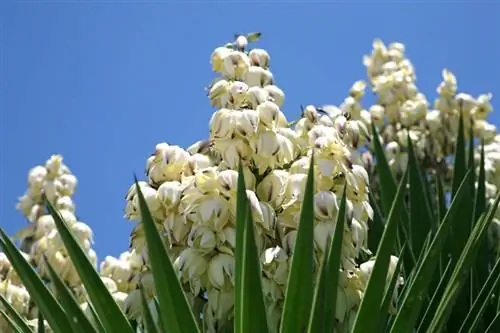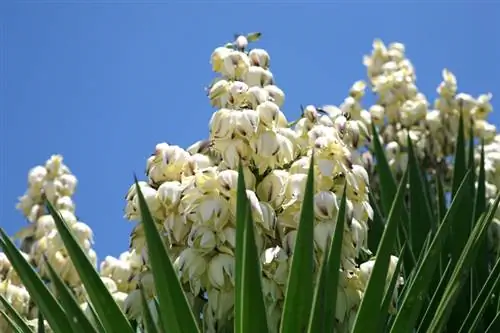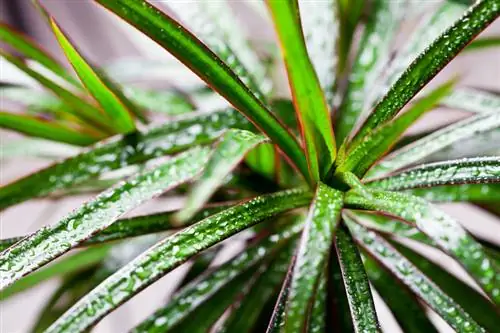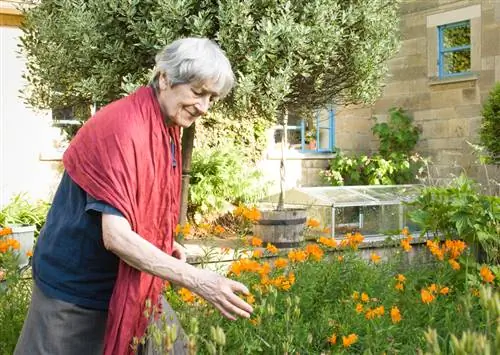- Author admin [email protected].
- Public 2023-12-25 17:45.
- Last modified 2025-01-23 11:22.
The palm lily fills rooms, balconies and beds with an exotic ambience without requiring extensive care. For many a beginner, the yucca paves the way into hobby gardening. Basic questions about plants and care are answered briefly and succinctly here.

How do you care for a palm lily?
A palm lily needs a sunny to partially shaded location and moderate watering with soft water. Avoid waterlogging and fertilize every 14 days from April to September. Pruning in spring and transplanting or transplanting if necessary.
Care tips
One of the likeable characteristics of a yucca is its undemanding nature, because professional care is limited to these factors:
- Watering moderately with soft water
- Remove excess water from the planter
- Fertilize every 14 days from April to September
Place the palm lily in a sunny to partially shaded location. The tolerable temperature level of non-hardy species and varieties ranges from 12 to 27 degrees Celsius. No special precautions are required to increase the humidity.
Cut the palm lily correctly
If the palm lily grows over your head or loses its harmonious silhouette with age, a courageous pruning will solve the problem. Cut a yucca in early spring with a sharp, disinfected knife or saw. The plant willingly sprouts again from its sleeping eyes.read more
Propagate palm lily
A well-established palm lily provides the material for further specimens without our intervention. These are kindles that thrive at the base of the trunk. You already have the appearance of a finished yucca. To ensure that these daughter plants develop their own root system, proceed as follows:
- If there are at least 5 leaves on the child, cut them off with a knife
- Plant in peat sand or pricking soil and water with room temperature rainwater
- The rooting is progressing quickly in the partially shaded, warm window seat
As another method of propagation, use 20-30 centimeter long trunk pieces that are available after cutting back. Planted in a lean substrate, the cuttings root out of the sleeping eyes. It is important to note that the segments are used in the previous direction of growth.read more
How do I transplant correctly?
To transplant a palm lily in the bed, choose a dry, overcast day in spring or summer. Follow these steps professionally:
- Pick off the roots all around with the spade
- The diameter corresponds to the height
- Pick out the root ball with the digging fork or spade
- Plant in the prepared, new location exactly as deep as the yucca was previously
- Consolidate the soil and pour generously
If you replant a yucca in a pot, it is not necessary to separate the roots. It is important to note that there is drainage above the water drain in the new bucket to prevent waterlogging. A loose, loamy-sandy substrate with a portion of compost and a little perlite creates ideal growing conditions.read more
Is palm lily poisonous?
Palm lilies pose no he alth risk to humans. For pets, however, eating plant parts proves to be poisonous because it causes vomiting, diarrhea and cramps.read more
Palm lily not blooming
If a palm lily doesn't bloom in the garden, it is usually simply too young. Many species take up to 10 years before they present their flowers for the first time. If an older specimen refuses to flower, the location and culture conditions should be examined. Pests or disease also prevent flowering. We generally cannot expect flowers from an indoor yucca.read more
Is the palm lily an agave plant?
Although its common name suggests otherwise, a palm lily is not a palm tree. In fact, you have an agave plant in front of you from the asparagus family.read more
The palm lily as a houseplant
The prime example of a palm lily as a houseplant is the Yucca aloifolia. The gem impresses with a trunk up to 100 centimeters high and a crown of dark green sword leaves. Some varieties have green or red-edged leaves that underline their decorative value. How to properly care for Yucca as a houseplant:
- Sunny to partially shaded location
- Watering moderately without causing waterlogging
- Fertilize every 2 weeks from April to September
- Winter brightly from mid-November to early March at 12-14 degrees
- Water less and don’t fertilize
If the current planter is no longer sufficient, repot the palm lily at the end of winter dormancy. A structurally stable pot plant soil with lava granules or perlite is suitable as a substrate. Drainage made of grit or pottery shards from the bottom of the pot is essential.read more
The blossom of the palm lily
Their blossoms take our breath away when they appear. Until then, up to 10 years will pass. As a houseplant, a yucca usually does not produce flower heads. In the bed, however, tightly upright panicles with large bell-shaped flowers in white or cream unfold from June to September/October. These care measures have a beneficial effect on the willingness to bloom:
- Sunny, warm location, ideally protected by a wall or hedge
- Humose, well-drained substrate, without risk of waterlogging
- Balanced water and nutrient balance
read more
Propagate the palm lily by division
Since the trunk of a yucca has numerous vegetation points, you can divide it and grow new palm lilies from the segments. The pieces are at least 20 centimeters long. When cutting off the mother plant, pay attention to the polarity, because the stem pieces must be planted in the previous direction of growth so that they root.read more
Is the palm lily hardy?
Within the diverse genus with more than 50 species, there is a we alth of hardy palm lilies to discover. Classics for the garden are:
- Candle palm lily (Yucca gloriosa): hardy to -20 degrees
- Filamentous palm lily (Yucca filamentosa): hardy down to -15 degrees
- Blue palm lily (Yucca rostrata): hardy down to -21 degrees
The palm lilies only develop this frost hardiness in the security of the ground. When cultivated in a large bucket, winter protection is essential so that the root ball does not freeze.read more
The most beautiful varieties
- Candle palm lily: stem-forming, branched yucca with magnificent flowers when old, hardy down to -25 degrees
- Marginata: the gray palm lily forms a trunk with a crown of dark green, yellow-edged leaves; hardy
- Quadricolor: colorful variety with green, stiff leaves, white, yellow and reddish stripes; Conditionally hardy
- Family palm lily: a stemless yucca with beautiful bell-shaped flowers in June and July; hardy down to -25 degrees
- Dwarf palm lily: stemless leaf rosettes with a diameter of 25 cm and a 100 cm high inflorescence; hardy down to -20 degrees
- Giant palm lily: mighty yucca with heights of up to 10 meters and enormous inflorescences in summer; only partially hardy
- Big Bend: beautiful blue yucca with a spherical crown, cream-colored flowers and robust winter hardiness






